Yellow spots appeared on the leaves of cucumbers: what to do to save the harvest
Growing cucumbers presents a number of challenges. One of them is the yellowing of the leaves during different periods of the growing season. This phenomenon may have several reasons that need to be identified and eliminated in a timely manner.
The article will give a detailed answer to the question of what to do if on cucumber leaves yellow spots appeared.
The content of the article
Causes of the appearance of yellow spots on cucumber leaves
A change in the color of the leaves is the main sign of a disruption in the life of a plant. This fact serves as a signal to the vegetable grower: action to save the crop must be taken as quickly as possible. The nature of the yellowing of the leaves and its causes are different, which means they require a different approach to treatment.
Lack of micro and macro elements
The most common cause of yellow leaves is chlorosis. This disease occurs due to metabolic disorders in the plant and a malfunction in the production of chlorophyll. The source of the disease is a lack of micro and macro elements in the soil.
Reference. There are two types of nutritional deficiencies in cucumbers: temporary (due to a violation of root nutrition when transplanting seedlings into the ground or cold snaps) and chronic.
To understand what the plant needs, study the location and nature of the leaf spots: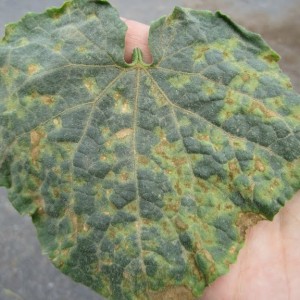
- Yellowness between veins indicates the need for iron and copper... This type of disease most often affects cucumbers, starting from the upper leaves on the shoots. Plants planted in calcareous soil suffer from it.
- If the lower leaves are affected, especially at the edges, we are talking about a deficiency of potassium and magnesium. This happens in beds located on sandy soil.
- Due to the lack of sulfur or manganese withthe beginning of the young leaves turn yellow in veins, and then the entire leaf plate changes color.
- Plants planted in acidic or alkaline soil will suffer from the need for nitrogen. The nature of yellowing in this case is the defeat of the lower leaves at the center, they gradually dry out.
Diseases
Viral and fungal diseases can prevail in greenhouse and soil crops. Most often, vegetable growers are faced with powdery mildew, fusarium, peronosporosis and anthracnose.
Powdery mildew
The causative agents are spores that have the ability to overwinter on plant remains. If small yellow specks appear on the leaves, which gradually grow and cover the entire leaf area, you are faced with this particular disease. The pigmentation grows from the bottom of the plant to the top. Over time, the seedling may die.
Fusarium
Fungal disease dangerous to the crop. It overtakes, as a rule, cucumbers that are grown in greenhouses or greenhouses. The signs are easy to spot: first, the tops of the leaves turn yellow and wither, then the root turns brown and the stem begins to rot.
Peronosporosis
The disease is given by yellow spots on the tops of the leaves and a greenish bloom. A distinctive feature of peronosporosis is the ability not only to spread over the entire surface of cucumbers, but also to infect all plantings nearby.
Anthracnose
The result of the lesion is areas on the foliage that are yellow-brown in color, which are accompanied by a pink bloom on the rest of the plant. Mucus appears on the cucumbers, causing small ulcers to form. This leads to the death of the plant.
Important! Pathogenic microorganisms are spread by seed and survive well in the ground.
Pests
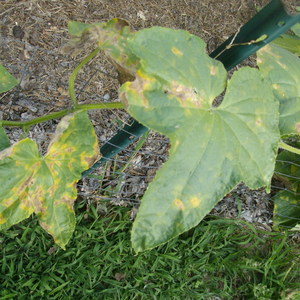
It is possible that the reason for the yellowing of the leaves is the "attack" of pests. Examine the back of the damaged sheet. Aphids, spider mites or whiteflies can be found there. Since the parasites feed on the sap of the plant, the tops are gradually depleted and begins to turn yellow and dry.
The whitefly is a small butterfly that settles in the garden along with the seedlings. If it is she who is to blame for the damage to the plant, we advise you to cut off and destroy the damaged leaves.
Spider mite destroys cucumbers that are planted in the open field and in the greenhouse. A sign of its appearance - the leaf is shrouded in a thin, barely noticeable cobweb. Despite its small size, the spider mite can lead to the death of the plant.
Burn or hypothermia
The plant reacts to uncomfortable conditions. Failure to comply with the temperature regime causes the appearance of a yellow tint of the sheet plate. The cold interferes with full-fledged photosynthesis, as a result, the plant does not fully assimilate nutrients.
Cases of cucumber burns are common. This happens when the seedlings come into contact with the hot or cold coating of the greenhouse (wall or glass window).
Reference. Temperature indicators are considered comfortable for cucumbers: before the appearance of fruits during the day - + 20 ... + 24 ° C, at night - + 17 ... + 18 ° C; during fruit ripening during the day - + 21 ... + 26 ° C, at night - + 18 ... + 20 ° C.
Care errors
We propose to consider the most common mistakes in the care of cucumbers, which are made not only by beginners, but also by experienced vegetable growers.
Improper watering
Excess moisture displaces air from the soil. This leads to a disruption in the oxidation of organic substances and a slowdown in the absorption of nutrients. Culture likes moderate and persistent watering... The soil must not be overmoistened or overdried: it is recommended to pour a couple of buckets of water per 1 m² of soil.
Lack of light
A very common reason. Often the problem is due to a too dense planting. If the interval between plants of 40-60 cm is observed, the root system develops correctly, the aerial part is comfortably located, the necessary compounds are absorbed in sufficient quantities.
Excessive lighting
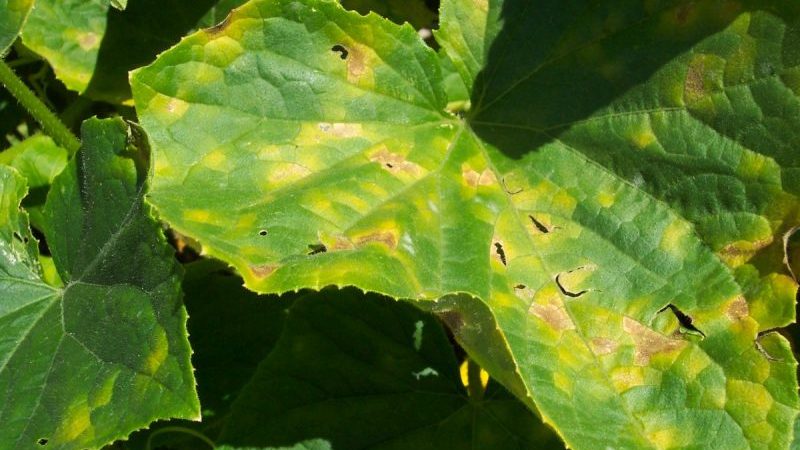
The polar problem is the excessive influence of sunlight. The most favorable place for full-fledged growth of cucumbers will be in light partial shade. This minimizes the risk of leaf burns and changes in soil moisture.
Hypothermia
If the plant had to be planted in cold soil, it will almost certainly be affected by diseases. Sometimes cucumbers not only freeze in growth, but also react with a change in their general appearance.
Frequent airing
Cucumbers do not like wind and draft; they prefer still moist air. It is not difficult to create such conditions in a greenhouse or greenhouse, but problems can arise in open ground. Try to plant your cucumbers out of the wind.
Injury
Carelessness in weeding cucumbers, that is, mechanical damage to the root of the plant, also leads to a deterioration in its condition and yellowing of the leaves.
Plant starvation
For normal functioning, cucumbers need feeding. An imbalance in the application of fertilizers or their absence will cause a shortage of useful micro and macro elements.
Why do yellow spots appear on cucumber leaves
The reasons for the yellowing of cucumber leaves are common and relate to different varieties. However, the location of the beds can influence the predisposition to a particular problem.
In the greenhouse
No matter how hard you try to provide vegetable crops with comfort in a greenhouse or greenhouse, there are a number of factors that affect their health:
- some varieties of cucumbers may suffer from insufficient pollination - this is a consequence of poor ventilation, when insects cannot reach the plants;
- overheating of cucumbers in a greenhouse is a very common phenomenon: constant exposure to sunlight causes an excessive increase in temperature, which has a negative effect on the plant;
- planting cucumbers and tomatoes in the same greenhouse is dangerous with an increase in the risk of infections.
In the ground
In the open field, vegetable crops are vulnerable if you do not create comfortable conditions for them:
- the unchanging arrangement of cucumber beds from year to year is fraught with problems - the soil is depleted, and pathogens accumulate;
- the root system of cucumbers is sensitive - watering with cold water will harm the plant;
- sudden changes in temperature contribute to the appearance of fungus on cucumbers.
What to do about it
Agrotechnical techniques and feeding will help get rid of yellowness on the leaves. If the reason for the yellowing of the leaves lies not in care, chemical and folk remedies will come to the rescue.
Chemicals
In specialized stores there is a huge selection of cucumber treatment products:
- "Fitosporin", a biologically active drug, will help to rid cucumbers of bacterial and fungal infections. The solution is sprayed on the plants every 10-14 days as needed.
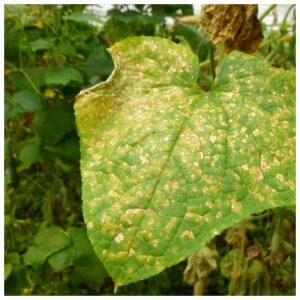
- Bordeaux liquid is a remedy for the most advanced forms of diseases. They are processed no more than twice a season.
- "Aktara" is a complex preparation for the destruction of pests.
- "Glyocladin" is used for fungal infections to combat their pathogens. The prepared solution is added under each bush that needs processing.
- Fungicide "Maxim" is one of the most effective drugs in the fight against late blight.
Traditional methods
If you do not want to resort to chemicals when growing vegetables, folk tricks will come in handy:
- At the first appearance of yellowness on the leaves, garlic infusion will help. To prepare it, grind a few cloves and fill them with a liter of warm water. Let it brew for about a day. Then strain the resulting infusion through cheesecloth, dilute in a bucket of water and add a little laundry soap. The plant is sprayed with this solution several times.
- Infusion of onion peels will effectively solve the problem with pests. The solution is prepared simply: boil the onion peel, insist and cool to room temperature. Spray the leaves of the plant with the solution or pour into each well in a liter jar of infusion.
- The recipe for a milk-soap "cocktail": in 10 liters of water add 1 liter of milk, 20 g of laundry soap and 30 drops of iodine. Process cucumbers with it every 10 days until you get the effect.
- Bread with iodine is an effective remedy for harvest rehabilitation. Soak a loaf of bread (black or white) in a bucket of water and leave overnight. Mash the bread in the morning and add a jar of iodine. To obtain a solution for spraying, dilute 1 liter of concentrate in 10 liters of water.
- Spraying with potassium permanganate is the easiest and most affordable way to combat yellowing of foliage and prevent plant treatment.
Agrotechnical techniques
The main reason for the occurrence of fungal diseases in seedlings is a violation of agricultural technology. Constant fluctuations in temperature and humidity provoke processes of mycelium growth. Cover the planting with film when the temperature drops, make sure that the leaves are not located near the cold glass of the greenhouse or window.
Plant burns can be the result of evaporation of water droplets that remain after watering. Make sure the foliage is completely dry.
Reference. When watering, the soil should be moistened to a depth of about 10 cm. The use of humus, peat chips and sawdust will protect the soil from excessive evaporation.
Unlike infection by a fungus, there is no protection against viruses.Only preventive measures can save: compliance with crop rotation, dressing of soil, seeds and cleansing of plant residues.
Top dressing
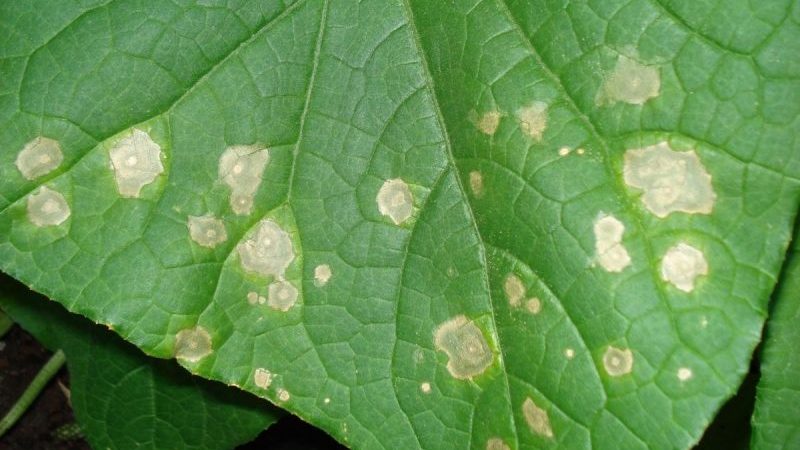
If the plant lacks nutrients, enter fertilizing:
- from chemical dressings, NPK complexes or a mixture of superphosphate, potassium sulfate and ammonium nitrate diluted with water in a 1: 1 ratio are suitable;
- urea solution is allowed to be used for root and foliar dressing;
- in case of potassium deficiency, add an ash top dressing or onion infusion;
- slurry or special nitrogen fertilizers will help fill the nitrogen deficiency;
- The best natural fertilizer for cucumbers will be herbal infusion based on comfrey.
How to prevent the problem
Preventing a problem is much easier than dealing with its consequences.
Measures to prevent yellowing of cucumber leaves are simple, but effective:
- loosen the soil after each watering and precipitation;
- to clear the beds from weeds that can "thicken" them;
- disinfect seeds before planting;
- pour warm water, directing it under the root, and not over the leaves;
- fertilize cucumbers, apply dressings strictly in the doses indicated in the manufacturer's instructions.
Tips for experienced summer residents
When growing cucumbers, advice from experienced summer residents will be useful:
- Immediately after planting cucumbers, mulch the soil around the bushes and between the rows. This will trap moisture and prevent weeds from growing.
- Feed every two weeks with nitrogen fertilizers for growth, potash for fruiting.
- If you plant dill or cucumber grass next to cucumbers that have pollination problems, they will attract insects and prevent the plants from dying.
Conclusion
Improper care, lack of trace elements, diseases and pests are the main reasons for yellowing of leaves on cucumbers. If all preventive measures are taken, the risk of yellow spots on cucumber leaves minimal. By applying simple maintenance rules, you will get healthy plants and a rich harvest.